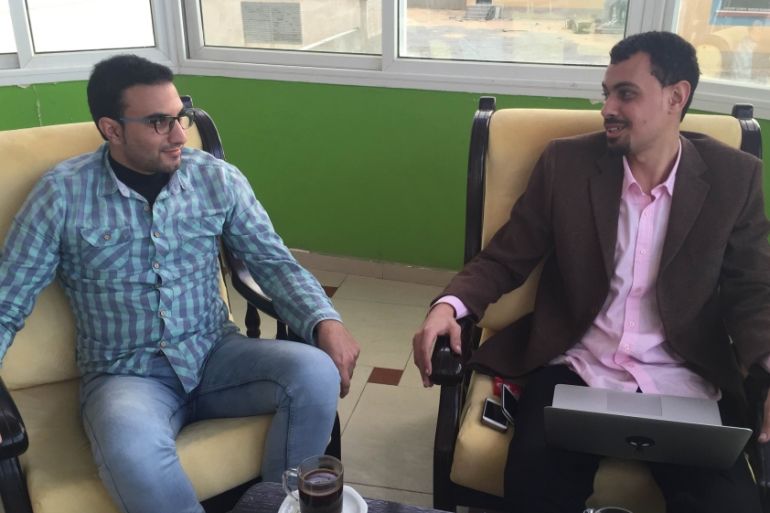Gaza Happy video: Two years later, the joy has faded
The light-hearted video was meant to show another side of Gaza, but the territory’s crisis only deepened amid 2014 war.

Gaza City – Anees al-Farra, 25, was just preparing to graduate from university when he became involved in creating the Gaza version of the Pharrell Williams Happy music video, which has been replicated in cities all over the world since its 2013 release.
The Gaza edition of the video was published on April 17, 2014, just a few months before Israel launched a fresh assault on the besieged territory. The 2014 Gaza war lasted two months, killing more than 2,000 Palestinians and leaving the area in ruins.
Keep reading
list of 4 itemsPalestinian Prisoner’s Day: How many are still in Israeli detention?
‘Mama we’re dying’: Only able to hear her kids in Gaza in their final days
Europe pledges to boost aid to Sudan on unwelcome war anniversary
Ironically, Farra’s goal when he decided to dance in the video was to help to show another side of Gaza – not the afflicted territory so often depicted in the mainstream media, but a happy place, full of joy and life.
“Our idea was to show that Gaza, despite its special conditions, has a different side of happiness and joy,” Farra told Al Jazeera. “We wanted to share the happy moments we live in Gaza, away from the effects of wars, siege and the difficult situation.”
Most of the people who appeared in the Gaza Happy video showed up randomly and started dancing the moment the music was turned on, producer Anas Hamra said – and many of them have since left Gaza for good.
“Even the one who came up with the idea of making a video, Mohammad Barakat, has left for the United States,” Hamra, 26, told Al Jazeera. Others have been looking elsewhere for job opportunities that are scarce in Gaza, where economic trends are so dire that the territory could be uninhabitable within just a few years’ time, according to the United Nations.
|
|
One girl who danced in the video while clad in a headscarf was subsequently criticised for violating societal norms, Hamra said. “Her name was Reem,” he recalled. “She called us to talk about the amount of [negative feedback] she got for showing up in the video, but she didn’t seem to care much about people’s negative opinions – and then she moved out.”
At the time the video was filmed, Farra was looking to start his own business in the e-finance sector, and was also hoping to travel to the US to broaden his horizons and seek out networking opportunities. But after the war broke out, all of his plans were thrown into disarray.
In October 2015, a couple of months after the war ended, Farra again tried to arrange to get a visa to visit the US, but his application was rejected at the Jerusalem consulate.
“Witnessing what the war had done to us, and watching my friends fall down one by one, made me reconsider my life in Gaza,” he said. “When you put a bird in a cage, all his dreams will be focused on getting out of that cage, to fly and see the world.”
But after failing to secure the visa, Farra – unlike many of the others who danced with him in the Gaza Happy video – realised that he was in Gaza to stay. After obtaining funding from a Gaza-based incubator, he launched his own company, CashU, which focuses on online payment solutions and is headquartered in Khan Younis.
If happiness existed in Gaza, it would be temporary, with an expiry date that would wipe it all away.
Farra and his friends have made other videos in the past to highlight Gaza’s plight, but none with the same level of success or virality as the Happy video, which was retweeted by Pharrell Williams himself.
In addition to those who criticised the video for cultural reasons, others disapproved because they did not think Gaza should be portrayed as a “happy” place, he noted. “These criticisms did not stop us,” he said, “though we felt sad … We wanted to do more videos, but the 2014 war stopped us. We no longer sing about happiness. Gaza lacks happiness now, with the war on Gaza, losing friends, the siege, the closure of the borders and restrictions on travelling.”
During the war, Farra volunteered with a group of youth to bring mattresses to displaced people, some of whom were sheltered in local schools. The experience affected him deeply.
“Some barefoot people came to a nearby school; I will never forget this scene,” he said.
READ MORE: The orphans of Gaza
Since the war, many young people have fallen into depression, with some contemplating suicide and others looking for any way out of Gaza, he noted. The territory has been described as the world’s largest open-air prison.
These days, Farra spends much of his free time in a garden on the roof of his home. “This makes me happy,” he said. “I prefer to spend my time at my garden, instead of chatting to my friends about things that make me feel sad. I spend much of my time on the internet watching comedy and drama.”
He is frustrated that his ill mother cannot obtain proper medical treatment outside Gaza owing to the Israeli-Egyptian blockade, and finds it difficult to see a brighter future for his family.
“If happiness existed in Gaza,” he said, “it would be temporary, with an expiry date that would wipe it all away.”